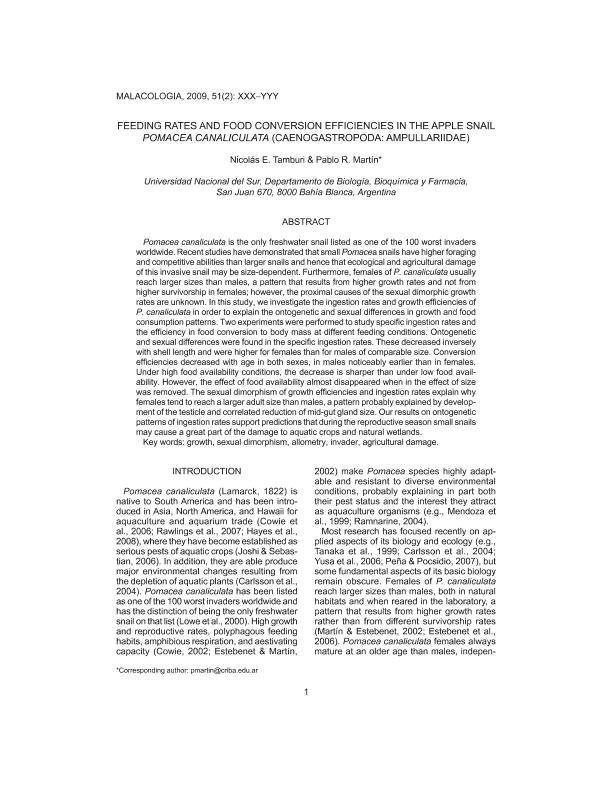Mostrar el registro sencillo del ítem
dc.contributor.author
Tamburi, Nicolas Eduardo

dc.contributor.author
Martín, Pablo Rafael

dc.date.available
2019-03-11T18:17:37Z
dc.date.issued
2009-08-01
dc.identifier.citation
Tamburi, Nicolas Eduardo; Martín, Pablo Rafael; Feeding rates and food conversion efficiencies in the apple snail pomacea canaliculata (Caenogastropoda: Ampullariidae); Institute of Malacology; Malacologia; 51; 2; 1-8-2009; 221-232
dc.identifier.issn
0076-2997
dc.identifier.uri
http://hdl.handle.net/11336/71356
dc.description.abstract
Pomacea canaliculata is the only freshwater snail listed as one of the 100 worst invaders worldwide. Recent studies have demonstrated that small Pomacea snails have higher foraging and competitive abilities than larger snails and hence that ecological and agricultural damage of this invasive snail may be size-dependent. Furthermore, females of P. canaliculata usually reach larger sizes than males, a pattern that results from higher growth rates and not from higher survivorship in females; however, the proximal causes of the sexual dimorphic growth rates are unknown. In this study, we investigate the ingestion rates and growth efficiencies of P. canaliculata in order to explain the ontogenetic and sexual differences in growth and food consumption patterns. Two experiments were performed to study specific ingestion rates and the efficiency in food conversion to body mass at different feeding conditions. Ontogenetic and sexual differences were found in the specific ingestion rates. These decreased inversely with shell length and were higher for females than for males of comparable size. Conversion efficiencies decreased with age in both sexes, in males noticeably earlier than in females. Under high food availability conditions, the decrease is sharper than under low food availability. However, the effect of food availability almost disappeared when in the effect of size was removed. The sexual dimorphism of growth efficiencies and ingestion rates explain why females tend to reach a larger adult size than males, a pattern probably explained by development of the testicle and correlated reduction of mid-gut gland size. Our results on ontogenetic patterns of ingestion rates support predictions that during the reproductive season small snails may cause a great part of the damage to aquatic crops and natural wetlands.
dc.format
application/pdf
dc.language.iso
eng
dc.publisher
Institute of Malacology

dc.rights
info:eu-repo/semantics/openAccess
dc.rights.uri
https://creativecommons.org/licenses/by-nc-sa/2.5/ar/
dc.subject
Agricultural Damage
dc.subject
Allometry
dc.subject
Growth
dc.subject
Invader
dc.subject
Sexual Dimorphism
dc.subject.classification
Otras Ciencias Biológicas

dc.subject.classification
Ciencias Biológicas

dc.subject.classification
CIENCIAS NATURALES Y EXACTAS

dc.title
Feeding rates and food conversion efficiencies in the apple snail pomacea canaliculata (Caenogastropoda: Ampullariidae)
dc.type
info:eu-repo/semantics/article
dc.type
info:ar-repo/semantics/artículo
dc.type
info:eu-repo/semantics/publishedVersion
dc.date.updated
2019-02-05T19:52:33Z
dc.journal.volume
51
dc.journal.number
2
dc.journal.pagination
221-232
dc.journal.pais
Estados Unidos

dc.journal.ciudad
Filadelfia
dc.description.fil
Fil: Tamburi, Nicolas Eduardo. Consejo Nacional de Investigaciones Científicas y Técnicas. Centro Científico Tecnológico Conicet - Bahía Blanca. Instituto de Ciencias Biológicas y Biomédicas del Sur. Universidad Nacional del Sur. Departamento de Biología, Bioquímica y Farmacia. Instituto de Ciencias Biológicas y Biomédicas del Sur; Argentina
dc.description.fil
Fil: Martín, Pablo Rafael. Consejo Nacional de Investigaciones Científicas y Técnicas. Centro Científico Tecnológico Conicet - Bahía Blanca. Instituto de Ciencias Biológicas y Biomédicas del Sur. Universidad Nacional del Sur. Departamento de Biología, Bioquímica y Farmacia. Instituto de Ciencias Biológicas y Biomédicas del Sur; Argentina
dc.journal.title
Malacologia

dc.relation.alternativeid
info:eu-repo/semantics/altIdentifier/url/https://bioone.org/journals/malacologia/volume-51/issue-2/040.051.0201/Feeding-Rates-and-Food-Conversion-Efficiencies-in-the-Apple-Snail/10.4002/040.051.0201.short
dc.relation.alternativeid
info:eu-repo/semantics/altIdentifier/doi/http://dx.doi.org/10.4002/040.051.0201
Archivos asociados
